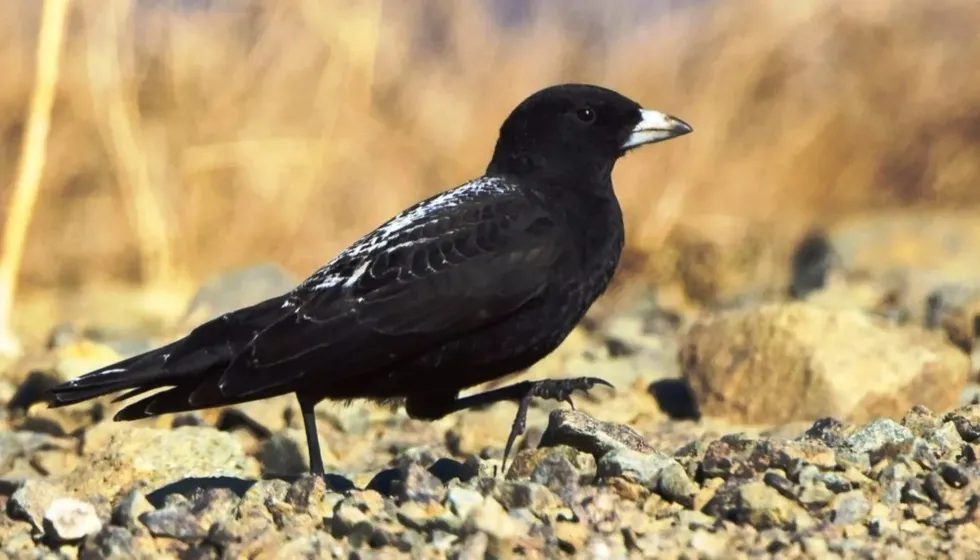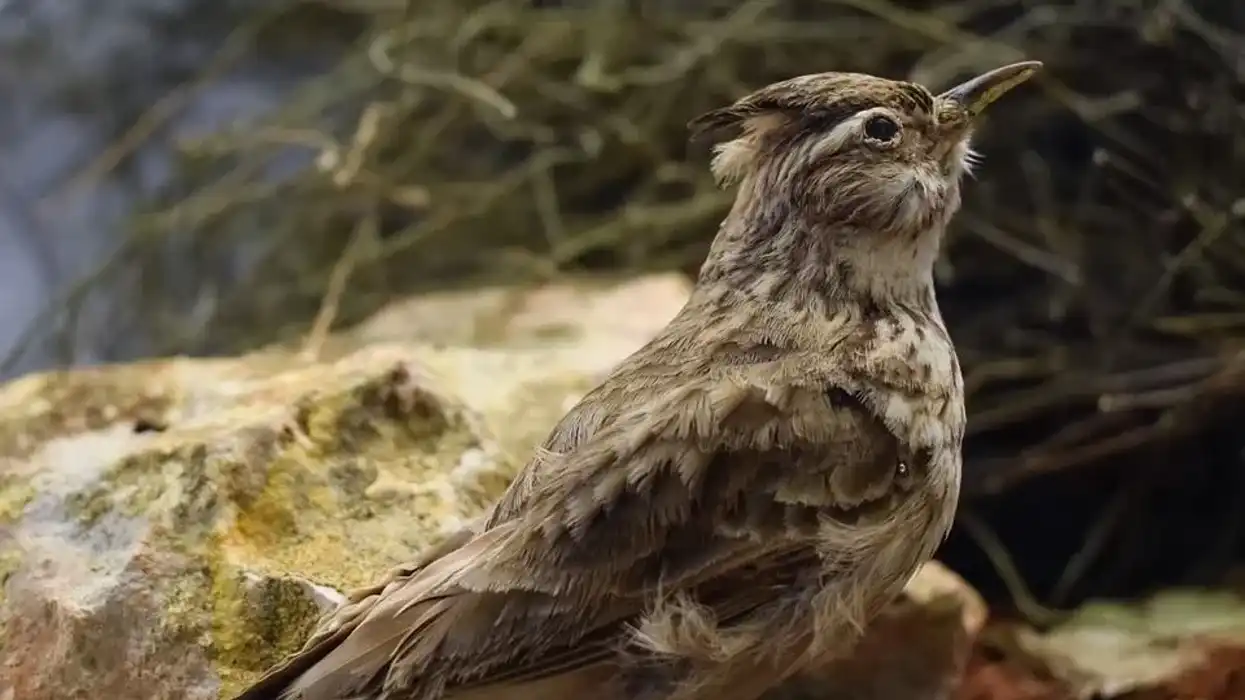While most of us are familiar with the magpie lark birds sporting a black and white mosaic of feathers, there is another lark species named after their pitch-black plumage - the black lark!
There are over 90 extant species of larks in the family Alaudidae, and the black lark (Melanocorypha yeltoniensis) is one of them. It belongs to the genus Melanocorypha, which also consists of four other lark species, namely, the Tibetan lark (Melanocorypha maxima), the Mongolian lark (Melanocorypha mongolica), the Calandra lark (Melanocorypha calandra), and the bimaculated lark (Melanocorypha bimaculata).
Lark species are pretty cosmopolitan and are found on almost every continent with the highest distribution in Africa. The black lark is found in Kazakhstan and parts of Russia.
The species is partially migratory and usually moves further southeast of its breeding range into Russia and adjoining countries.
The birds primarily inhabit grassy steppes, preferably with wet patches and scattered shrubs or bushes. Black larks forage on the ground and feed on seeds and invertebrates.
Read on if you want to know more about the amazing Melanocorypha yeltoniensis! If you like what you read, do check out interesting facts about other bird species such as the frigate and greater bird-of-paradise.
Black Lark Interesting Facts
What type of animal is a black lark?
The black lark (Melanocorypha yeltoniensis) is a lark species belonging to the family Alaudidae.
What class of animal does a black lark belong to?
The black lark (Melanocorypha yeltoniensis) belongs to the class of birds.
How many black larks are there in the world?
The global population estimate of the black lark species is not available. However, as per the International Union for Conservation of Nature (IUCN) Red List of Threatened Species, the black larks have a globally decreasing population trend.
Where does a black lark live?
The black lark range includes northern Kazakhstan and southwestern Russia from the west of River Volga to Lake Zaysan. To the south, the range extends to the northern shores of the Aral Sea, Caspian Sea, and north of Lake Balkhash.
The birds spend the winter further south of their natural breeding range in the Black Sea region, northern Iran, Caucasus, Turkmenistan, Uzbekistan, and southern Kazakhstan.
The species is a short-distance migrant outside of its breeding range and has been recorded in several European countries, Lebanon, Turkey, and Mongolia. The black lark bird has been reported from the European countries in spring, autumn, as well as in winter.
What is a black lark's habitat?
The black lark (Melanocorypha yeltoniensis) naturally inhabits open, grassy steppes, especially those with scattered shrubs and wet patches. The bird may also be found in saline semi-desert habitats.
Who do black larks live with?
Outside the breeding season, the adult black larks form single-sex flocks. The flocks of male birds are usually larger than the female flocks. However, flocks consisting only of male birds are often seen during the peak breeding season as well.
How long does a black lark live?
An estimate of the lifespan range of the black lark is not available. Most lark bird species of the family Alaudidae live for an average of two to five years. The longest-living larks known are a skylark (Alauda arvensis), aged eight years and five months, and a seven-year and 11 months old horned lark (Eremophila alpestris).
How do they reproduce?
The breeding season spans from late March to August, with slight variations between the north and south of their range. Mating is preceded by spectacular aerial displays by the male bird.
It undertakes high song flights with raised and fully extended wings and a fanned tail, giving the impression as if it is growing. For breeding, the female bird builds a nest in the ground, usually a depression under tufts of grass.
The nest is often surrounded by animal dung and lined with finer grass.
The dung barricade helps in keeping the nest cool and reduces the risks of trampling. Post breeding, the female of the species lays about two to eight eggs in the nest, although a clutch size of four to five eggs is most common.
The female incubates the eggs alone for about 15-16 days, and the small black lark chicks are fed by both the male and female parent. The young larks are known to leave the nest when they are about 9-11 days old.
What is their conservation status?
As per the International Union for Conservation of Nature (IUCN) Red List, the black lark (Melanocorypha yeltoniensis) is a species of Least Concern.
Black Lark Fun Facts
What do black larks look like?
The black lark (Melanocorypha yeltoniensis) gets its name from the coal-black plumage of the males of the species. In general, the birds have a heavy build, broad wings, a rather large bill, and a short tail.
The adult males are in fresh plumage in autumn, and during this time, the feathers are unmistakably black with broad, buff-colored tips. In spring, the pale feather tips wear away, and the plumage is almost entirely black by the time it is summer.
The legs are dark gray, and the bill is pale gray, often with a dark-tipped upper mandible. In winter, the bill assumes a more yellowish tinge.
In contrast to males, the female larks are duller with an undistinguished appearance. In autumn, the female birds don pale brownish-gray feathers with indistinct dark markings on the upper body and whitish feathers below.
The breast is buffish with obscure dark spots.
Unlike the coal-black spring plumage of the males, the female bird's worn feathers are overall dark with heavy streaks above and below. The juvenile larks look more or less similar to the females with worn plumage, except the former have distinctive pale feather fringes and dark subterminal bands.

How cute are they?
The stout and plump build of the dark lark makes them look quite adorable. Besides, the fascinating change in color of feathers across the seasons lends the larks a mystic and charming aura.
How do they communicate?
The black lark is quite a vocal bird and communicates through songs in flight, on the ground, or on a low perch. The bird's call includes various squeaky and buzzy notes, and the songs are usually a series of drawn-out warbles, whistles, and chatters.
How big is a black lark?
An adult black lark measures between 7.5-7.8 in (19-19.8 cm), with the females being slightly smaller than the males. The black larks are almost the same size or perhaps a bit larger than the horned larks.
How fast can a black lark move?
No information is available regarding how fast a black lark moves.
How much does a black lark weigh?
A black lark weighs about 1.8-2.4 oz (51-68 g).
What are the male and female names of the species?
Male and female larks do not have distinct names.
What would you call a baby black lark?
Lie all young avians, a baby lark would be called a chick or fledgling.
What do they eat?
The black larks are omnivores, feeding on seeds and small invertebrates. The summer diet mostly comprises invertebrates like flies, bugs, spiders, larval and adult beetles, and various other lepidopterans, myriapods, and hymenopterans.
Some reports also suggest that the summer diet comprises abundant seeds and plant material. In winter, members of the species feed exclusively on seeds.
The bird is a ground-forager and can browse for seeds even when the ground is covered with snow. It digs down into the ground and creates channels and tunnels in the snow to look for food.
Are they dangerous?
While most other lark species are considered agricultural pests, the black lark generally does not associate with farmlands. Otherwise, the bird is not known to be particularly dangerous. However, larks of the family Alaudidae are quite territorial and can get pretty defensive about their nests using songs and flight displays.
Would they make a good pet?
The black lark is not usually kept as a pet. In China, it is traditional to keep larks as a pet and teach them to mimic other songbirds.
Did you know...
The black lark population is threatened due to livestock farming and loss of habitat to steppe cultivation.
The specific epithet of the black lark, yeltoniensis, is inspired by Lake Yelton, located in Volgograd Oblast, Russia.
Common natural predators of larks include owls, falcons, weasels, shrikes, skunks, raccoons, squirrels, voles, mice, house cats, crows, shrews, and the western meadowlarks.
What is special about black larks?
What makes the black lark so special is its unique plumage. In summer, the males are coal-black, a unique feature among larks that makes Melanocorypha yeltoniensis so famous!
Comparisons with other lark birds
The most prominent difference between the black lark and other lark species is that the black lark males sport unmistakable black plumes. Other larks mostly have paler, brown feathers that almost match the soil color.
Some also have tufts of plumes crowning their head. All larks are omnivorous and forage on the ground for invertebrates, seeds, and other plant matter.
Here at Kidadl, we have carefully created lots of interesting family-friendly animal facts for everyone to discover! For more relatable content, check out these bowerbird facts and umbrellabird facts for kids.
You can even occupy yourself at home by coloring in one of our free printable scarlet robin coloring pages.
Second image by Francesco Veronesi from Italy.










